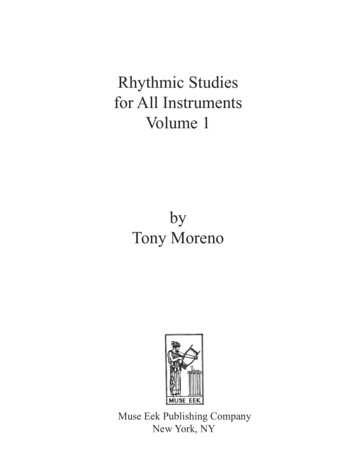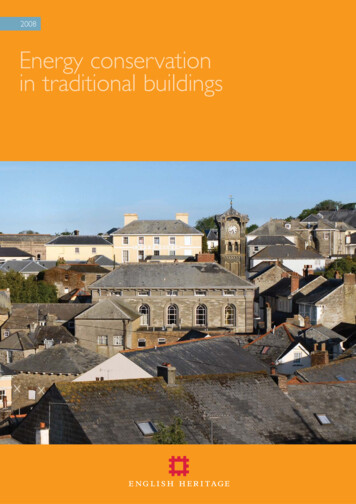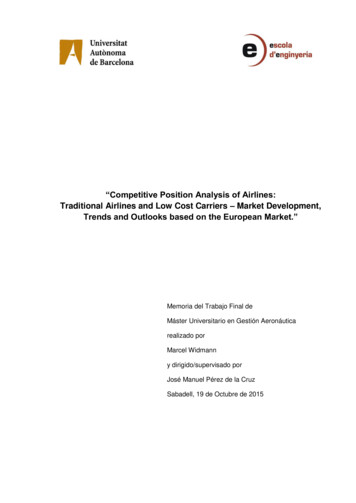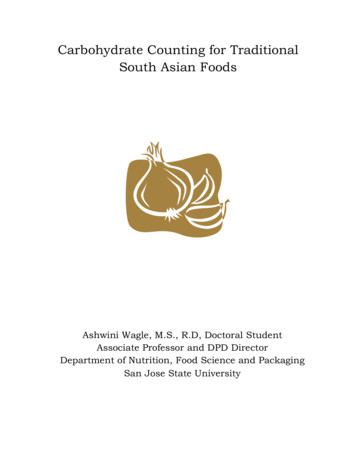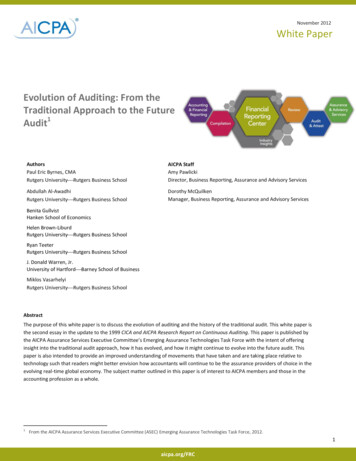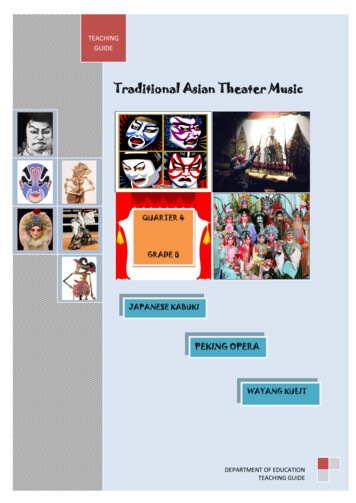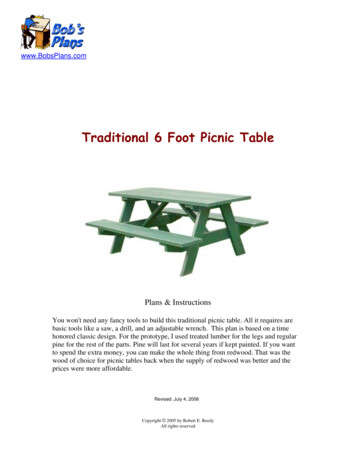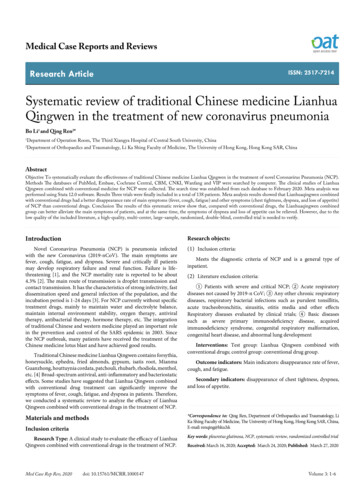
Transcription
International Journal of Humanities and Social ScienceVol. 4, No. 9(1); July 2014Traditional Rhythmic Patterns: The Source of Creativity and Identity of OriginalNigerian Art Music CompositionsSunday OfuaniLecturer, Department of MusicDelta State UniversityAbraka, Nigeria.AbstractThe truism that African music lays emphasis to rhythm than harmony, tone and its color reveals that the creativeinput of African music making is essentially embedded on rhythmic considerations – the hallmark of its musicalidentity. This paper considers the compositional efforts of Nigerian late 20th and 21st century’s art musiccomposers in drawing rhythmic patterns or structures from its traditional music. Hence, the finding that therhythmic creativity of such practice is the major factor that has placed diverse original African art music stylesand genres (e.g. African pianism, drummistic-piano, native-air and African-vocalism etc.) as distinct andidentifiable art music type across the globe. This research essentially depends on published art musiccompositions of some Nigerian-Igbo academic musicians. Thus, in order to identify and elucidate the rhythmicpatterns and structures that are prompted by traditional rhythmic motifs, it studies, analyzes and discusses somecompositions in the tendency. The outcomes of the research are significant and beneficial for theoretical analysisof African rhythms and further utilization of the identified rhythmic techniques by diverse African and nonAfrican art music composers. This paper is not interested in establishing pedantic theories of African rhythms, soit goes direct in applied sense to demystify rhythm as the central tool for initiating creativity, Africanism andidentity of contemporary Nigerian art music composition.Keywords: art music; composition; contemporary; creativity; identity; Nigeria/Africa; rhythm; traditional musicIntroductionFrom ancient times, Africans have expressed its sonic-visual culture in unprecedented multi facets that integrateto holistic music or performance. These sonic-visual traits are seen and perceived from its tonality, harmony,vocalism, timbre, instrumentation, dance, mode of performance among others. And, rhythm serves as the creativenucleus or cement that binds them together. Consequently, of the entire musical elements with which traditionalAfricans have expressed its musical culture/heritage, their rhythmic ingenuity is the foremost element thattransverses, appeals and attracts music audience and researchers/writers across the globe. This is simply becausethe art of rhythm in Africa is fascinating and it eludes the Europeans (and other worlds’) rhythmic skills andconsiderations. Hence, the quintessence of rhythm in African music was long ago noted by Senghor in Chernoff(1979: 56) who confirms that, “Rhythm is the basis of all African art”, and Jones (1959: 40) who points out that“Rhythm is to the African what harmony is to the Europeans.” Roger (2002: 391) corroborates the assertions, ashe certifies that “Rhythm and percussion are highly emphasized in African music, reflecting the close linkbetween music and dance. African music tends to feature complex polyrhythm; in which, several differentrhythmic patterns are play simultaneously and repeated over and over, and each instrument goes its own rhythmicway.”Against this veracity, most pioneer African art music composers essentially indulged in composing works thatcharacterized occidental rhythmic patterns/structures and other compositional idioms. By nationalismconsideration, the practice earned them little or no identity in their immediate society and across the globe. Incontemporary times (from late 20th century) however, some composers of the same took a ‘U-turn’ by imbibingnationalistic-composition approach, which introduced variety of original indigenous art music genres/styles. (See:Ogisi, 2008 and Onyeji, 2011).And so, in referring to original Nigerian art music genres or styles, we hear and say African pianism, drummisticpiano, native-air and African-vocalism etc.162
Center for Promoting Ideas, USAwww.ijhssnet.comQuite often, I indulged in critical and analytical inquiry in order to ascertain the principal attribute of Africanmusic that supports and elicits the above indigenous art music genres/styles as distinct and original toAfrican/Nigerian. The apt conclusion always settles to African rhythmic nuance.Thus, it becomes imperative that this paper investigates traditional African rhythmic motifs and diverse styles ofharnessing and nurturing or propagating its ideals, spirit and creativity in contemporary Nigerian art musiccomposition.Space constrains this paper from sampling musical scores of the compositions studied/analyzed. And so, to enablediverse readers’ access to the compositions in reference, published compositions like: native-airs in Agu (1998)and the drummistic-piano style employed as accompaniment to some of the African-vocalism solos in Onyeji(2008) is here the representative of African art music compositions that essentially replicate African rhythmictendency. However, some unpublished compositions of Joshua Uzoigwe and Okechukwu Ndubuisi (O’Ndu) arealso considered.Rhythmic Techniques in Contemporary African Art MusicAfrican rhythm is deliberately created. Quite often, it captures and bears certain images, abstractions and codes(musical and non-musical) that appeal to the cultural and emotional sentiments of African societies. But mostessentially, rhythms often prevail according to its role in any African traditional music ensemble. Some of whichare rhythmic pattern(s) that projects/initiates timeline, gravity, balance, dance, onomatopoeic imitation,indigenous musical structures/forms, societal sonic-rhythmic codes, theatrical and communal sentiments andsignal orientations. There are also those that derived from speech-rhythm attribute of various Africanlanguages/words. However an academically trained music composer adapts and balances all the above withintellectual reasoning, which enables him/her to simulate any traditional rhythmic patterns into art music, therebyachieving new rhythmic crafts with clear undertone that replicates or suggests its prototype. Hence, rhythmictechniques in contemporary African art music are discussed under the subsequent subtopics.Simulation of Indigenous Rhythmic Patterns for the Piano and VoiceSome contemporary Nigerian art music composers employ various rhythmic patterns derived from indigenousmusic of Africa as the rhythmic basis/theme of their art music composition. One of such composers is ChristianOnyeji, who in his drummistic-piano technique utilizes indigenous rhythmic patterns. But then, the derivedrhythmic motif usually provides him with ample creative rhythmic environment, because assorted rhythms alwaysemerged as consequence of subjecting the prototype rhythm to his personal creativity. He confirms that:This layer [that is the referent-rhythmic pattern layer, which he calls the phrasing referent creative stimulationlayer] consists of a single melorhythmic pattern that is repeated, as in Igbo traditional music. This pattern givesme creative stimulation for the sequencing of surging musical motions Quite often this is simulated for thepiano in a way it captures the monotone sound in the traditional music transformed Continuous playing of thispattern in the right hand of the piano for the unfolding instrumental and vocal layers results to rhythmiccounterpoint, multilinear rhythmic organization and polyphonic textures that characterize the songs. (Onyeji,2005: 31)1. The referent rhythmic pattern: Rhythms under this category is what I refer to as orientational-rhythmicpattern. This embraces any rhythmic pattern/motif that is fundamentally ascribed to any African musicalinstruments that essentially feature or play the role of time-line or metronome in an ensemble. Nketia (1963)confirms that “One of the regular means of establishing and maintaining the beat is the accompanying rhythmplayed by the idiophone. Any of these [gong, woodblock etc.] provides a timeline, a constant point of reference bywhich the phrase structures of a song as well as the linear metrical organization of phrases are guided.” In Igbotraditional music and indeed among all West African traditional societies, instruments like ogene/agogo (metalbell) and okpokolo (wood block) etc play the well-known/common characteristic timeline rhythm in an ensemblein cyclic form. Thus:163
International Journal of Humanities and Social ScienceVol. 4, No. 9(1); July 2014Although, the starting-point of the above timeline rhythmic pattern differs among diverse African ethnic groupsand individuals, the aural perception of its resultant rhythm is always the same. As to Igbo traditional music,Ekwueme (2004: 197) recognizes diverse starting-points and patterns of the rhythm.This is confirmed by Vidal, (2005: 23) who also elucidates the diverse starting-points of the same rhythm.According to him the rhythmic motif above is the seventh mode of the orientational-rhythmic pattern.In Onyeji’s compositions, the orientational-rhythmic motif is only replicated in the right-hand side of the piano,precisely within the range of C4 and B5.1 The rationale behind the choice of the range is to enable the simulatedrhythmic mode assume its proper rhythmic-acoustic potentials of piecing tonal-range and volume. King (1960:53) notes that “The choice of the highest pitched instrument for this role corresponds with the normal Africanpractice, it being a matter of common sense that the instruments supplying the rhythmic link should be easilyrecognizable, e.g. bells and gongs through their high pitch ” Hence, there is no better register of the piano thatcan project the relative rhythmic-timbre of the agogo much more than the ranges he employed. For example, in:bars 11, 12, 14, 15, 17, 18, 28, 29, 31 & 32 of Inine and (almost) throughout Giri giri; Agu gburu nne na nna ya;Mbombo; Ughu no re’i so; Hi ya; Mma mma and Hi yom, the orientational-rhythmic pattern consistently revolvedwithin the aforementioned piano range.According to Ekwueme (2004: 197), in traditional music performance, “The rhythmic pattern (orientationalrhythmic pattern) is cyclic form. It is repeated over and over throughout any piece of music. Consequently, it hasno definite beginning or end.” The assertion is quite true and Onyeji maintains it in his compositions. Althoughthe technique contributes in enhancing the development or extension of his compositions, in his efforts to inducecontrast and eliminate elements of monotony of the recurring orientational-rhythmic pattern, he rationally adoptsrhythmic: tonal-shift, note addition/cluster, note elimination and variation etc. techniques where necessary. Forinstance, in song No. 17 entitled Hi ya, which is characterized with the orientational-rhythmic mode; theintroduction (bar 1 to 4) provides the enactment of the rhythm with single A5 register. At bar 5, C5 is added andboth notes (C5 A5) were sustained up to bar 16. There is tonal-shift of the same rhythm to F4 D5 at bar 17 and itcontinued up to bar 24. In bar 25, lone A4 prevailed. Bar 26 recaptures the C5 A5 and retaining it up to bar 37.Bar 38 to 43 essentially depicts rhythmic contrast through variation technique. At bar 44 the F4 D5 is sustainedup to bar 47. From bar 48 to 51 the rhythm was altered in such a way that the orientational-rhythmic pattern isstill perceived. From bar 52 the predominant rhythmic-tone (C5 A5) in the piece is recapitulated and sustained tothe end. It is interesting to observe that in bars 22 and 23 the vocal solo doubles the piano accompanimentrhythmic-tone using the poetic-syllable texts (kon kon ko kon kon kon ko) with which ogene/agogo is rhythmicallyand onomatopoeically known all over West Africa. He essentially used the technique to emphasis the simulatedrhythm.It is also relevant to point out that in the piano accompaniment of the song, the rhythmic-tones (C5 A5) whichstarted from the beginning of the piece and continues up to bar 16 was subjected to tonal-shift (F4 D5) at bar 17.However the same rhythm and interval is maintained with the preceding one. I call this style – rhythmic sequence(see Ofuani, 2012).I cannot afford to constrain this paper from yet another model of indigenous orientational-rhythmic pattern thatOnyeji utilized or applied in some of his compositions. Thus, it is appropriate to cite/reveal the pattern heemployed in his Nka emume songs No. 15 and 19 entitled Agada giri and Di gam respectively. Thus:The above orientational-rhythmic pattern, which is peculiar with the well-known Ohaofia-war dance musicserved as the rhythmic theme in the two works. Hence, Agada giri and Di gam drew and portray the characteristicrhythmic pattern of the musical arts (Ohaofia-war dance) simulated. By and large, the songs and theaccompaniment music strictly followed the rhythmic tendency and creativity rationales of the preceding andsubsequent discussions of Onyeji’s technique of African rhythm simulation.2. The drummistic rhythmic pattern: Nketia, (1958: 24) identifies three modes of drumming in Africantraditional music and these are: signal, speech and dance modes of drumming.164
Center for Promoting Ideas, USAwww.ijhssnet.comBut he goes further to state that “the dance mode of drumming is by far the most frequently used. Drums used inthis mode are accompanied by gongs or gongs and rattles In this mode of drumming, single drums andidiophones may be used for playing the required dance rhythms.”The above assertion is well entrenched in Onyeji’s art music compositions, where drum(s) rhythmic-tone patternsare captured in the left hand of the piano. Rhythms under this category enable him to initiate and stimulategravity, balance and dance sentiments etc during the performance of his compositions.According to him “the lower part of the piano simulates drum patterns similar to those found in a typical women’sdance group ” (Onyeji, 2005: 43
The referent rhythmic pattern: Rhythms under this category is what I refer to as orientational-rhythmic pattern. This embraces any rhythmic pattern/motif that is fundamentally ascribed to any African musical instruments that essentially feature or play the role of time-line or metronome in an ensemble. Nketia (1963) confirms that “One of the regular means of establishing and maintaining the .

